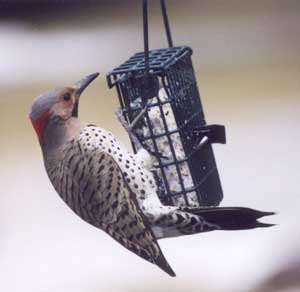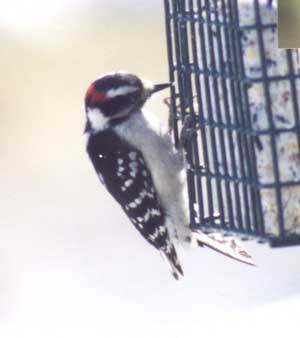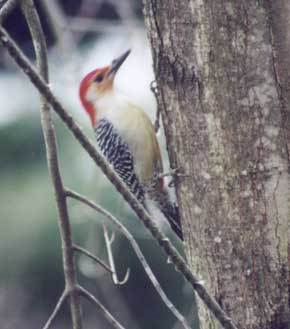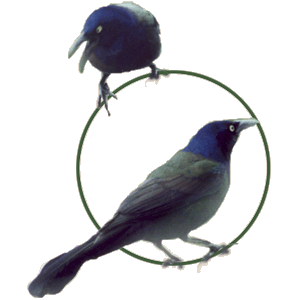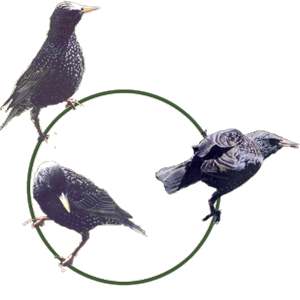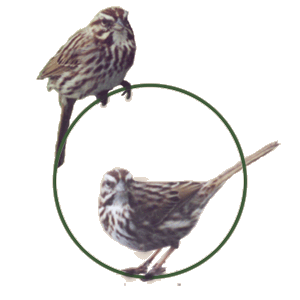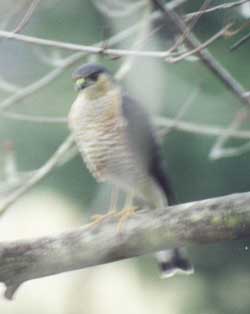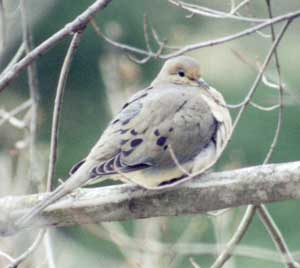 |
|
| Birds Native Animals of North Jersey |
|
| Scenery • Geography • Maps • Bears • Birds • Recreation |
Common Birdfeeder Visitors (Cont'd)
Common
Yellow Shafted Flicker The Northern Flicker is a common species, yet trends indicate this species’ numbers are declining, particularly the eastern race (known as the Yellow-shafted Flicker). Possible reasons may include the general maturing and closing of forests in the East and the use of pesticides on lawns and other feeding areas. Flickers build nests in tree cavities and produce three to ten eggs in a clutch. Eggs are approximately one inch in diameter and are white with a few black spots.
Downy
Woodpecker Downy Woodpeckers are found in woodlands and river groves. They are easily confused with their larger cousins, the Hairy Woodpecker. Downy Woodpeckers are small, approximately six ( ~15 cm). The Downy is the most common woodpecker in North America and is the fourth most common bird sited at feeders. The male defends his personal space and will chase off other birds trying to feed near it. The Downy woodpeckers' diet consists mainly of insects, but will eat seeds and fruit. The Downy Woodpecker, like the flicker, makes it's nest in tree cavities. The normal clutch size is three to six eggs each approximately three quarters of an inch in diameter.
Red-Bellied
Woodpecker Red-bellied Woodpeckers have zebra-like markings on the back with males having red capped heads. The female is similar but has the red only on the nape of the neck. The "red-belly" is really very faint and only viewable under perfect conditions. Red-bellied Woodpeckers will eat seed in winter and can be regularly attracted to feeders. Red-bellied woodpecker's diet consists mainly of nuts and fruit with lesser quantities of insects. The Red-bellied Woodpecker, in common with other members of the picidae family, nest in cavities. They have between three and eight eggs per clutch.
Common
Grackle Grackles display an iridescent head with either a bronze or purple body. Grackles are found in farmlands, towns, groves and streamsides. They eat seed, waste grain, small fruits and small aquatic life. They are known to eat small lizards, minnows and small bats. They are in the same family, Icteridae, as Blackbirds and Orioles. As with other members of their family, Common Grackles tend to gather in large flocks or troupes. They are migratory birds and assemble in the thousands for their journey in early fall. Grackles will nest by the breeding pair alone or in colonies in evergreen trees. Nests are bulky and made of twigs, grasses, feathers, and mud. Eggs are pale green and blotched with brown and lavender. The breeding season occurs from March until July.
European
Starling The European Starling was introduced in the 19th century to North America. It is heavily speckled in winter with a dark bill. The Starling's bill lightens to a yellow and the body becomes more iridescent in the spring. European Starlings have short tails and are about six inches in length. European Starlings are very common and are found in large flocks. They are very adaptive and found in almost all habitats; cities, parks, farms, open groves, fields and other open areas.European Starlings are easily attracted to suet feeders. Their usual diet consists of insects, seeds and berries. Starlings nest in cavities in the canopy of trees or in buildings. They will have two to three broods of four to seven eggs. Incubation time ranges from twelve to fourteen days.
Song
Sparrow The Song Sparrow is fairly common and ranges from about five to six inches in length. These birds prefers shrubby habitat and brushy cover along streams, ponds and other wetlands. They also like rural roadways with shrubby cover and rural back yards. The Song Sparrow's vocalization is one of the most attractive of the sparrows. Song Sparrows eat insects in the summer by foraging through bushes, grasses and trees for grasshoppers, beetles, flies, wasps and other insects. It will also eat grass and weed seeds as well as some waste grain and wild fruit. Nests are either on the ground hidden by clumps of weeds and grasses or in shrubby cover a few feet off the ground. Deer have been known to predate on the ground nest sites of sparrows***.
Sharp
Shinned Hawk Similar to the Coopers Hawk, the Sharp Shinned Hawk feeds mainly on birds and occasionally small mammals. The adult is a blue-grey with a white breast marked by thin reddish bars. Both sexes are similar with the female larger. The Sharp Shinned Hawk is approximately 10.5 inches with a wingspan of 21 inches. Sharp Shinned Hawks are short-range migratory birds and are found mostly in woodlands. Sharp-shinned hawks are hunters that prey primarily on small birds and mammals. They hunt in wooded areas and dense brush flushing small birds and then overtaking them in flight; or by sitting on a perch and watching for unsuspecting prey. Once prey is captured, the sharp-shinned hawk takes it to a site known as the "butcher block" or "plucking perch" where the prey is plucked and then eaten. The most commonly taken prey is the robin as it is easily caught. The Sharp Shinned Hawk nests from April to July. It usually has four to five eggs in a clutch and a long incubation period of 32-35 days.
Sharp
Shinned Hawk Food Hawk Food sometimes appears on the ground as scattered feathers. Seriously, the Mourning Dove (Family Columbidae, Zenaida macroura) is a fine meal for hawks. Mourning Doves share the same family and are similar to pigeons. They have a pale buff-brown head, neck, breast, and belly. Mourning Doves are approximately ten and a half inches in length and are identifiable by their pointed tails. . They almost exclusively seed eaters. Mourning Doves have two to three broods of usually two eggs each, but are known to have up to 6 broods. Incubation time is approximately fourteen days.
|
||||||||||||||||||||||||||||||
|
Bird watching is an interesting and inexpensive hobby. All that's needed to begin is a good field guide such as Roger Tory Peterson's "A Field Guide to the Birds" . Identification of birds is easy with Peterson's excellent illustrations highlighting distinctive marks. The book also includes instructions on identification of birds, habitat maps and a "life list" for recording a siting. Another good accessory is a pair of binoculars as birds are usually fidgety things and are hard to get close to. A decent set of binoculars helps find birds in treetops and is nearly indispensable for viewing Red Tail Hawks and other raptors. Bird watching can bring many years of enjoyment (and adventure!) and New Jersey is a birdland with it's varied habitats and place on the migratory route. Next time you are relaxing outside with the birds chirping, take a look around for our modern day dinosaurs. Related Websites:
|
||||||||||||||||||||||||||||||
|
sources: * Songbirds of North Dakota, Northern Prairie Research Center, Chris Grondahl, Scott Gomes ** Science News, Vol 159, p 365, June 9, 2001 *** White-tailed Deer (Odocoileus virginianus) Predation on Grassland Songbird Nestlings, Pamela J. Pietz and Diane A. Granfors - A Field Guide to the Birds East of the Rockies- Peterson Field Guide Series, Roger Tory Peterson, 1980 - Building Nest Structures, Feeders, and Photo Blinds for North Dakota Wildlife |
 |
|||||||||||||||||||||||||||||
Home • Scenery • History • Recreation • Home & Garden • Directory • Calendar • Classified Ads
• Maps • Scenery • Shopping
Advertise on rt23.com!
• Link to rt23.com!

Questions, comments, corrections? contact the Webmaster
